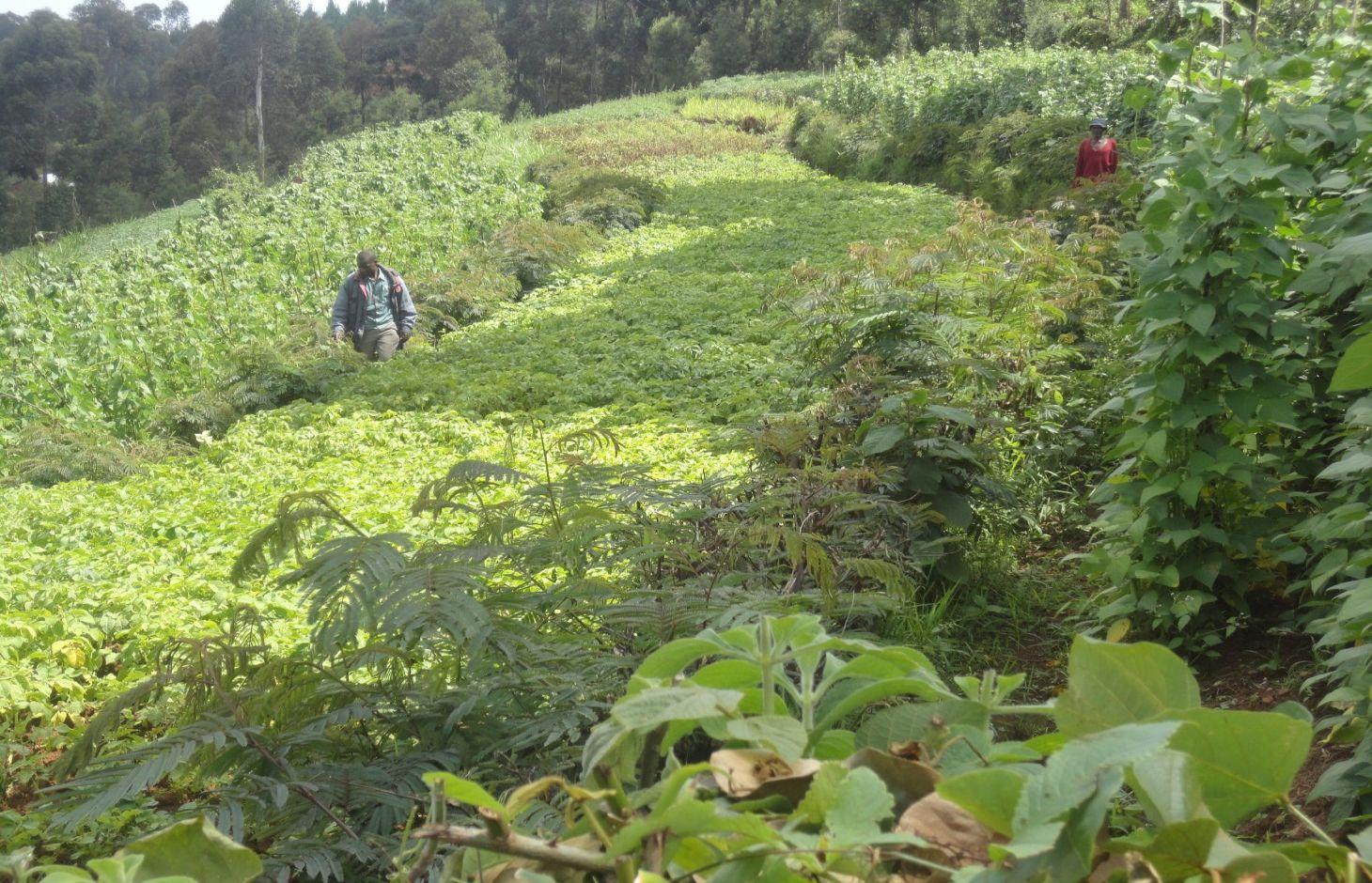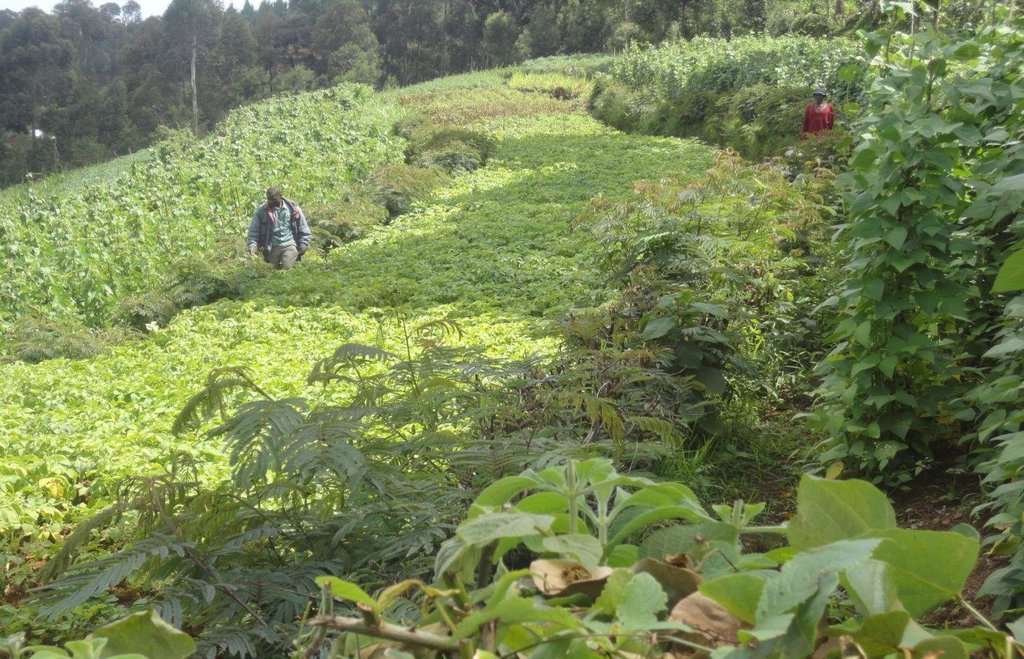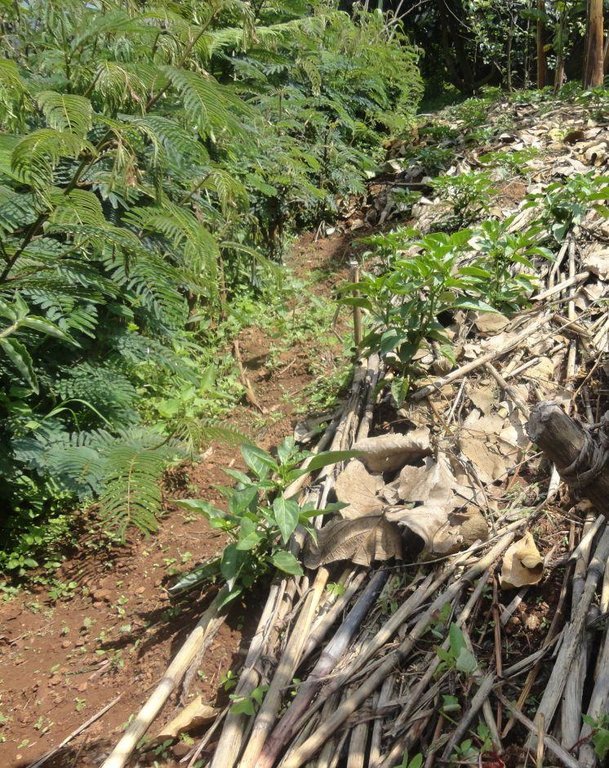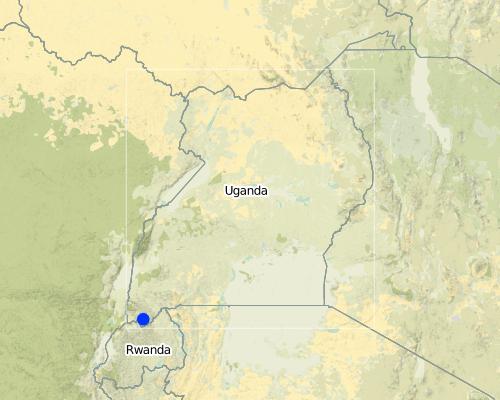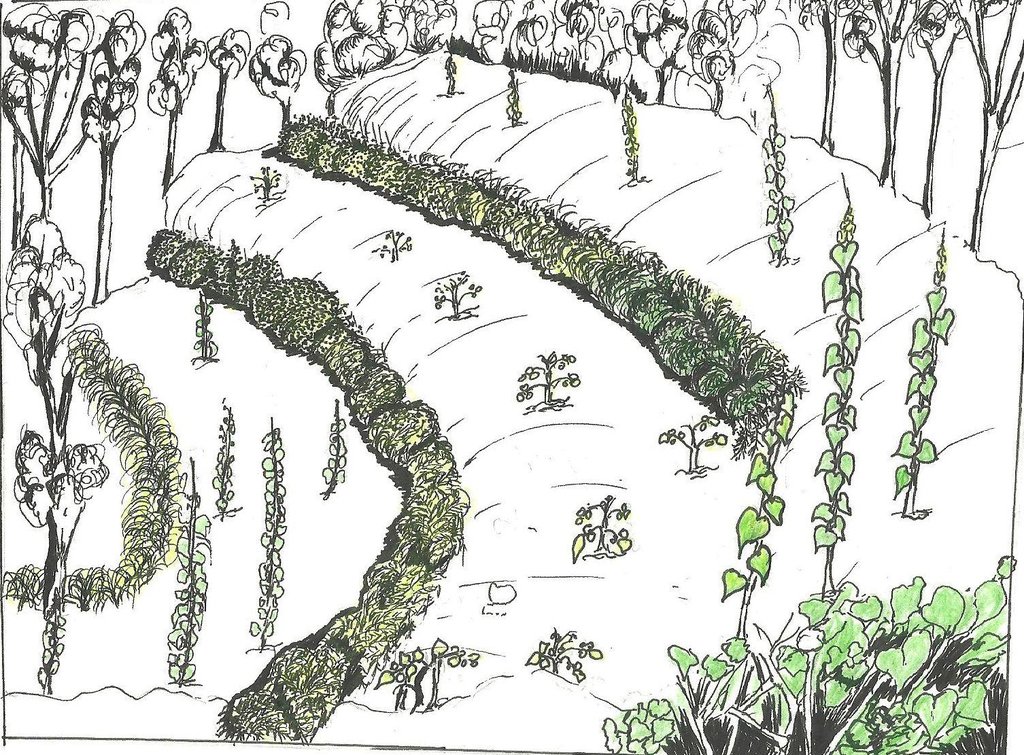Calliandra contour hedges [Uganda]
- Creation:
- Update:
- Compiler: Wilson Bamwerinde
- Editor: –
- Reviewer: Alexandra Gavilano
Orugo rwa Calliandra (Rukiga)
technologies_1178 - Uganda
View sections
Expand all Collapse all1. General information
1.2 Contact details of resource persons and institutions involved in the assessment and documentation of the Technology
Name of project which facilitated the documentation/ evaluation of the Technology (if relevant)
The Transboundary Agro-ecosystem Management Project for the Kagera River Basin (GEF-FAO / Kagera TAMP )Name of the institution(s) which facilitated the documentation/ evaluation of the Technology (if relevant)
Food and Agriculture Organization of the United Nations (FAO) - ItalyName of the institution(s) which facilitated the documentation/ evaluation of the Technology (if relevant)
Kabale District Local Government (Kabale District Local Government) - Uganda1.3 Conditions regarding the use of data documented through WOCAT
When were the data compiled (in the field)?
20/01/2014
The compiler and key resource person(s) accept the conditions regarding the use of data documented through WOCAT:
Ja
2. Description of the SLM Technology
2.1 Short description of the Technology
Definition of the Technology:
Contour hedges of Calliandra planted on very steep slopes to combat soil erosion by decreasing surface runoff and increasing infiltration.
2.2 Detailed description of the Technology
Description:
Calliandra Calothyrsus trees are closely planted along the contours on hilly and steep slopes to create natural and effective barriers for reduction of the surface runoff and retention of eroded sediment. Calliandra hedge barriers are a fairly cheap, effective, and sustainable way of controlling soil erosion and landslides on vulnerable steep slopes, especially where trash lines and Napier grass strips were inadequate to mitigate dispersed and concentrated soil and water runoff. Once established, the living barrier is durable with minimal additional maintenance cost to the farmer apart from pruning. The average length of a hedgerow is 50 to 70 m, corresponding to the width of a single terrace. The height varies according to intended use of the mature shoots. To use the stems as stakes, the hedgerow is allowed to reach a height of 4 to 6 m at maturity while a height of 1 to 2 m is sufficient for harvesting foliage as livestock fodder. The hedge barrier reaches its mature, maintenance level after 12 to 18 months.
Purpose of the Technology: The main purpose of the Calliandra hedge barrier is to reduce soil and water runoff.Calliandra is a leguminous shrub with deep roots that provids additional benefits such as soil stabilization and soil fertility improvement through nitrogen fixing. Calliandra is a source of fodder and its flowers attract bees.
Establishment / maintenance activities and inputs: At the beginning of the rainy season, calliandra seedlings are transplanted from the nursery (0.2m to 0.3m height) and planted in a row (0.3m spacing). In the early stages, gap-filling with more seedlings may be necessary as some fail to get established. A mixture of top soil and manure is applied in the spaces between the seedlings and watering is done to improve the seedling survival rate. The distance between rows is 10 to 15 m and depends on the gradient of the slope. Establishment of hedges starts with construction of an earth banked terrace, creating a trench at the lower end of the terrace. Calliandra seedlings are planted on the higher side of the trench. Measuring off 10 m lengths upwards into the terrace, other rows of Calliandra seedlings are planted along the contour in order to achieve the inter-row spacing. Establishment is manual labor intensive and therefore the community, organized as Farmer Field Schools, participates in the planting, one field at a time. Simple tools such as hand hoes, sokajembe (pick-axe) and shovels are used. Maintenance is achieved by weeding, mulching and cutting back. For it to establish well, Calliandra needs to be weeded to minimize competition with weeds for water and nutrients . The weeds also harbour pests. It may also be necessary to mulch the area around each seedling during the dry season. Where mulching is done, the mulch is placed at least 0.05m away from the plant to reduce pest attacks. Calliandra calothyrsus trees are cut back at a height of 2m to between 0.15m and 1m to improve foliage which is used as fodder for livestock. The hedge is then maintained at a height of 1 to 6 m depending on the intended additional uses. The branches removed can be used as fuel wood or stakes, while leaves can be used as fodder.
Natural / human environment: The hedge barrier may be attacked by pests. Scales are white, powdery insects that attack Calliandra stems. Scales can be controlled using washing detergents such as ‘Omo’ dissolved in water and sprinkled on affected plants using leafy branches or a knapsack sprayer. Black ants can seriously damage trees. They can be controlled by spraying. Other likely pests are crickets and grass hoppers which affect seedlings in nurseries, and Armillaria mellea, a fungus that attacks roots of Calliandra plant causing root rot and eventual death. Affected plants are uprooted and burnt. In addition, calliandra is affected by hot, dry weather. During the hot, dry weather, the hedge barrier becomes weak. However during the wet season it sprouts again, and, if well managed, becomes healthy again. A well-maintained hedge barriers can last well over 20 years.
2.3 Photos of the Technology
2.5 Country/ region/ locations where the Technology has been applied and which are covered by this assessment
Country:
Uganda
Region/ State/ Province:
Uganda
Further specification of location:
Kabale District
Comments:
Boundary points of the Technology area: -1.29294, 29.96006
-1.29336, 29.96027
-1.29327, 29.96084
-1.29371, 29.96095
-1.29345, 29.96091
Map
×2.6 Date of implementation
If precise year is not known, indicate approximate date:
- less than 10 years ago (recently)
2.7 Introduction of the Technology
Specify how the Technology was introduced:
- through projects/ external interventions
Comments (type of project, etc.):
The technology was introduced by ICRAF in 2006 and scaled-up Kagera TAMP project 2 years ago.
3. Classification of the SLM Technology
3.2 Current land use type(s) where the Technology is applied

Cropland
- Annual cropping
Main crops (cash and food crops):
The landuser majorly grows beans (climbing ) as food and cash crop.

Grazing land
Main animal species and products:
The animals reared depend on improved pasture such as calliandra
Livestock is grazing on crop residues
Comments:
Major land use problems (compiler’s opinion): The slopes are steep >30% to very steep >60%), with very high precipitation (>1440 mm). Severe surface erosion and landslides may occur at the beginning of the rains, before sufficient vegetation covers the soil. Continuous cultivation with little external inputs and nutrient transfer affects negatively soil fertility and in results reduces crops growth/vegetation cover, leading to erosion on steep slopes.
Major land use problems (land users’ perception): Floods are common in the valleys over the past ten years.
Improved pasture: Diary hiefers,pigs(largewhite and layers)pasture include calliandra,stellia and elephant grass.
Constraints of settlement / urban: floods invade houses
Constraints of infrastructure network (roads, railways, pipe lines, power lines): transport problem
3.3 Further information about land use
Water supply for the land on which the Technology is applied:
- rainfed
Number of growing seasons per year:
- 2
Specify:
Longest growing period in days: 120Longest growing period from month to month: February to MaySecond longest growing period in days: 90Second longest growing period from month to month: September to November
Livestock density (if relevant):
1-10 LU /km2
3.5 Spread of the Technology
Comments:
Total area covered by the SLM Technology is 0.03 m2.
The documented case study area is around 3ha
3.6 SLM measures comprising the Technology

vegetative measures
- V1: Tree and shrub cover
Comments:
Type of vegetative measures: aligned: -contour
3.7 Main types of land degradation addressed by the Technology

soil erosion by water
- Wt: loss of topsoil/ surface erosion
- Wm: mass movements/ landslides
Comments:
Main causes of degradation: soil management (Poor vegetative cover/no trees to bind soil particles.), Heavy / extreme rainfall (intensity/amounts) (Rainfall intensifying in september and April.), other natural causes (avalanches, volcanic eruptions, mud flows, highly susceptible natural resources, extreme topography, etc.) specify (steep slopes (extreme topography)), population pressure (Population increase/no of people increased per sq km), poverty / wealth (lack of resources to implement known natural resources degradation mitigation measures)
Secondary causes of degradation: education, access to knowledge and support services
3.8 Prevention, reduction, or restoration of land degradation
Specify the goal of the Technology with regard to land degradation:
- prevent land degradation
- reduce land degradation
4. Technical specifications, implementation activities, inputs, and costs
4.1 Technical drawing of the Technology
4.2 Technical specifications/ explanations of technical drawing
Calliandra trees are planted in rows along the contour. Cutting back is done between 12 and 18 months to a height of 0.5 m. The trees are allowed to grow to between 1 and 6 m and the hedge is maintained at that height. Gap-filling, weeding and trimming are critical for a productive hedge.
Location: Bukoora, Kabale. Kabale/Uganda
Technical knowledge required for field staff / advisors: moderate (Such knowledge as is required to manage the Calliandra nursery, transplant and maintain the plants especially until the first coppice.)
Technical knowledge required for land users: moderate (The land user is responsible for maintaining the technology on his or her land and a good hedge requires diligence)
Main technical functions: control of dispersed runoff: impede / retard, control of concentrated runoff: impede / retard, improvement of ground cover, improvement of topsoil structure (compaction), stabilisation of soil (eg by tree roots against land slides), increase in nutrient availability (supply, recycling,…)
Secondary technical functions: control of raindrop splash, reduction of slope angle, reduction of slope length, increase of infiltration, increase of groundwater level / recharge of groundwater, sediment retention / trapping, sediment harvesting, increase of biomass (quantity)
Aligned: -contour
Vegetative material: T : trees / shrubs
Number of plants per (ha): 670 to 720
Spacing between rows / strips / blocks (m): 10
Vertical interval within rows / strips / blocks (m): 0.4
Width within rows / strips / blocks (m): 0.7
Trees/ shrubs species: Calliandra was planted
Fruit trees / shrubs species: n/a
Perennial crops species: n/a
Grass species: n/a
Other species: n/a
Slope (which determines the spacing indicated above): 40%
If the original slope has changed as a result of the Technology, the slope today is (see figure below): n/a%
Gradient along the rows / strips: <3%
4.3 General information regarding the calculation of inputs and costs
other/ national currency (specify):
UGX
Indicate exchange rate from USD to local currency (if relevant): 1 USD =:
2602.0
Indicate average wage cost of hired labour per day:
3.80
4.4 Establishment activities
| Activity | Type of measure | Timing | |
|---|---|---|---|
| 1. | Establishment of Calliandra nursery | Vegetative | Dry season |
| 2. | Plantation of Calliandra seedling on the higher side of the trench | Vegetative | Wet season |
| 3. | Weeding | Vegetative |
4.5 Costs and inputs needed for establishment
| Specify input | Unit | Quantity | Costs per Unit | Total costs per input | % of costs borne by land users | |
|---|---|---|---|---|---|---|
| Labour | Labour | 1.0 | 44.6 | 44.6 | 100.0 | |
| Equipment | tools | 1.0 | 16.2 | 16.2 | 100.0 | |
| Plant material | seedlings | 1.0 | 30.4 | 30.4 | 100.0 | |
| Plant material | seeds | 1.0 | 9.6 | 9.6 | 100.0 | |
| Total costs for establishment of the Technology | 100.8 | |||||
Comments:
Duration of establishment phase: 18 month(s)
4.6 Maintenance/ recurrent activities
| Activity | Type of measure | Timing/ frequency | |
|---|---|---|---|
| 1. | Prunning and triming the hedge barriers | Vegetative | wet/dry season |
4.7 Costs and inputs needed for maintenance/ recurrent activities (per year)
| Specify input | Unit | Quantity | Costs per Unit | Total costs per input | % of costs borne by land users | |
|---|---|---|---|---|---|---|
| Labour | labour | 1.0 | 20.8 | 20.8 | 100.0 | |
| Equipment | tools | 1.0 | 16.2 | 16.2 | 100.0 | |
| Plant material | seedlings | 1.0 | 1.0 | 1.0 | 100.0 | |
| Other | 100.0 | |||||
| Total costs for maintenance of the Technology | 38.0 | |||||
Comments:
Machinery/ tools: I panga,1 watering can, 1hoe.
The cost assesment above refers to steep slopes.
4.8 Most important factors affecting the costs
Describe the most determinate factors affecting the costs:
The cost of seedlings (0.20 US$ each) and their transport up along steep slopes are the key factors affecting costs and hindering spontaneous adoption of the technology. Otherwise, the technology is acceptable to farmers as benefits are easily visible in the short run.
5. Natural and human environment
5.1 Climate
Annual rainfall
- < 250 mm
- 251-500 mm
- 501-750 mm
- 751-1,000 mm
- 1,001-1,500 mm
- 1,501-2,000 mm
- 2,001-3,000 mm
- 3,001-4,000 mm
- > 4,000 mm
Agro-climatic zone
- sub-humid
Thermal climate class: tropics. at the Equator
5.2 Topography
Slopes on average:
- flat (0-2%)
- gentle (3-5%)
- moderate (6-10%)
- rolling (11-15%)
- hilly (16-30%)
- steep (31-60%)
- very steep (>60%)
Landforms:
- plateau/plains
- ridges
- mountain slopes
- hill slopes
- footslopes
- valley floors
Altitudinal zone:
- 0-100 m a.s.l.
- 101-500 m a.s.l.
- 501-1,000 m a.s.l.
- 1,001-1,500 m a.s.l.
- 1,501-2,000 m a.s.l.
- 2,001-2,500 m a.s.l.
- 2,501-3,000 m a.s.l.
- 3,001-4,000 m a.s.l.
- > 4,000 m a.s.l.
5.3 Soils
Soil depth on average:
- very shallow (0-20 cm)
- shallow (21-50 cm)
- moderately deep (51-80 cm)
- deep (81-120 cm)
- very deep (> 120 cm)
Soil texture (topsoil):
- coarse/ light (sandy)
- medium (loamy, silty)
Topsoil organic matter:
- medium (1-3%)
- low (<1%)
5.4 Water availability and quality
Ground water table:
> 50 m
Availability of surface water:
poor/ none
5.5 Biodiversity
Species diversity:
- low
5.6 Characteristics of land users applying the Technology
Market orientation of production system:
- mixed (subsistence/ commercial
Off-farm income:
- less than 10% of all income
Relative level of wealth:
- poor
- average
Individuals or groups:
- individual/ household
Level of mechanization:
- manual work
Gender:
- women
- men
Indicate other relevant characteristics of the land users:
Difference in the involvement of women and men: Maintenance such as pruning trimming is mostly done by the men, but the other activities are done by both men and women.
Population density: 200-500 persons/km2
Annual population growth: 2% - 3%; 3%
5% of the land users are rich and own 40% of the land.
30% of the land users are average wealthy and own 30% of the land (meets basic needs/necesities).
45% of the land users are poor and own 20% of the land.
20% of the land users are poor and own 10% of the land.
Off-farm income specification: Crop and animal production greatly increased for land users implementing conservation measures , compared to those who do not implement.
5.7 Average area of land owned or leased by land users applying the Technology
- < 0.5 ha
- 0.5-1 ha
- 1-2 ha
- 2-5 ha
- 5-15 ha
- 15-50 ha
- 50-100 ha
- 100-500 ha
- 500-1,000 ha
- 1,000-10,000 ha
- > 10,000 ha
Is this considered small-, medium- or large-scale (referring to local context)?
- small-scale
5.8 Land ownership, land use rights, and water use rights
Land ownership:
- individual, not titled
Land use rights:
- individual
Comments:
The land belongs to an individual with no title but has all the rights over it.
5.9 Access to services and infrastructure
health:
- poor
- moderate
- good
education:
- poor
- moderate
- good
technical assistance:
- poor
- moderate
- good
markets:
- poor
- moderate
- good
energy:
- poor
- moderate
- good
roads and transport:
- poor
- moderate
- good
drinking water and sanitation:
- poor
- moderate
- good
financial services:
- poor
- moderate
- good
n/an/an/an/a:
- poor
- moderate
- good
6. Impacts and concluding statements
6.1 On-site impacts the Technology has shown
Socio-economic impacts
Production
crop production
Quantity before SLM:
150
Quantity after SLM:
700
fodder quality
Quantity before SLM:
-
Quantity after SLM:
-
animal production
Quantity before SLM:
-
Quantity after SLM:
25
production area
Income and costs
farm income
Quantity before SLM:
1.5 million
Quantity after SLM:
3.5million
Socio-cultural impacts
food security/ self-sufficiency
SLM/ land degradation knowledge
Quantity before SLM:
-
Quantity after SLM:
-
conflict mitigation
Ecological impacts
Water cycle/ runoff
surface runoff
Soil
soil moisture
soil cover
soil loss
nutrient cycling/ recharge
Biodiversity: vegetation, animals
biomass/ above ground C
plant diversity
Other ecological impacts
increased pests
6.2 Off-site impacts the Technology has shown
downstream flooding
downstream siltation
damage on neighbours' fields
Quantity before SLM:
-
Quantity after SLM:
-
damage on public/ private infrastructure
Quantity before SLM:
-
Quantity after SLM:
-
6.3 Exposure and sensitivity of the Technology to gradual climate change and climate-related extremes/ disasters (as perceived by land users)
Gradual climate change
Gradual climate change
| Season | Type of climatic change/ extreme | How does the Technology cope with it? | |
|---|---|---|---|
| annual temperature | increase | well |
Climate-related extremes (disasters)
Meteorological disasters
| How does the Technology cope with it? | |
|---|---|
| local rainstorm | well |
Climatological disasters
| How does the Technology cope with it? | |
|---|---|
| drought | well |
Hydrological disasters
| How does the Technology cope with it? | |
|---|---|
| general (river) flood | well |
Other climate-related consequences
Other climate-related consequences
| How does the Technology cope with it? | |
|---|---|
| reduced growing period | not known |
| n/a |
6.4 Cost-benefit analysis
How do the benefits compare with the establishment costs (from land users’ perspective)?
Short-term returns:
negative
Long-term returns:
very positive
How do the benefits compare with the maintenance/ recurrent costs (from land users' perspective)?
Short-term returns:
negative
Long-term returns:
positive
Comments:
Benefits are high compared to establishment and maintenance cost
6.5 Adoption of the Technology
Comments:
88% of land user families have adopted the Technology with external material support
45 land user families have adopted the Technology with external material support
12% of land user families have adopted the Technology without any external material support
6 land user families have adopted the Technology without any external material support
There is a moderate trend towards spontaneous adoption of the Technology
Comments on adoption trend: The technology is appreciated by most farmers but adoption is limited by cost of seedlings and transportation up steep slopes
6.7 Strengths/ advantages/ opportunities of the Technology
| Strengths/ advantages/ opportunities in the land user’s view |
|---|
|
Calliandra binds the soil, thus reduces landslides. How can they be sustained / enhanced? It should be maintained through proper management |
|
Adds scenic beauty on a plot How can they be sustained / enhanced? By regular trimming |
|
Calliandra is good and attractive to bees How can they be sustained / enhanced? Leave every second or third row to flower |
| Strengths/ advantages/ opportunities in the compiler’s or other key resource person’s view |
|---|
|
It is easy to establish and maintain How can they be sustained / enhanced? Promote education campaign and spread information |
|
It has helped to increase crop and animal production How can they be sustained / enhanced? By proper management and not overgrazing animals |
|
Stabilize the soil and strenghtening resistance to intensive rainfall and fast runoff How can they be sustained / enhanced? Promote technology through increased community mobilization |
|
Very effective to reduce soil erosion How can they be sustained / enhanced? Combine with other practicies e.g. mulching |
6.8 Weaknesses/ disadvantages/ risks of the Technology and ways of overcoming them
| Weaknesses/ disadvantages/ risks in the compiler’s or other key resource person’s view | How can they be overcome? |
|---|---|
| The hedge barrier is ineffective before 12 months | Combine with trash lines before establishment |
| Technology harbors nesting birds | Ensure regular trimming of Calliandra to reasonable height and use scarecrows |
| Needs at least 2 seasons to establish | Apply manure and water to the seedlings to ensure accelerated growth |
| May reduce the amount of sunlight available to young crops if left untrimmed | Trim regularly |
| Extra cost in protecting from damage by livestock | Inter-crop with other fodder species to act as alternative fodder for livestock |
7. References and links
7.2 References to available publications
Title, author, year, ISBN:
Kagera TAMP Project website
Available from where? Costs?
http://www.fao.org/nr/kagera/en/
Links and modules
Expand all Collapse allLinks
No links
Modules
No modules


